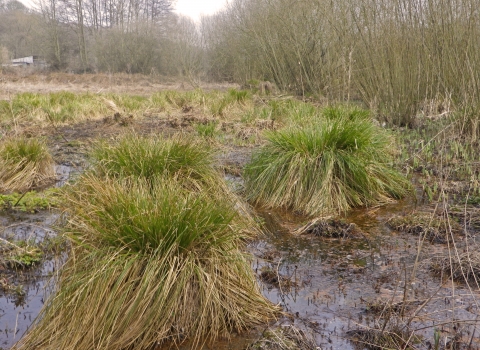Wilden Marsh
Know before you go
Dogs
When to visit
Opening times
Dawn to duskBest time to visit
All year roundAbout the reserve
Wilden Marsh consists of a series of dry and marshy fields with small alder and willow woods, reedbeds and drainage ditches – all with different flora and fauna.
The marsh, fed with water from nearby springs, lies on alluvial soils over impervious clays. It provides wet grazing land and, when possible, cattle are put onto the land to keep down the coarser plants and limit invasive scrub. Many of the old willows are pollarded on a cycle of about every 20 years. Marshland is becoming increasingly scarce in Worcestershire and this reserve contains many plants now uncommon elsewhere including marsh cinquefoil, marsh arrow-grass, marsh pennywort, lesser water parsnip and southern marsh orchid.
192 species of bird have been recorded on the reserve and include those typical of wet scrub including warblers. River species such as kingfisher are seen and it may be possible to see buzzard or any of the three species of woodpecker. Snipe and water rail are occasionally seen by volunteers working on the marsh.
The wet nature of the reserve was severely damaged by deep dredging of the Stour and the removal of a downstream weir in the 1970s. The resulting drying out of the marsh and significant reduction of plants has hopefully been reversed. Together with the Environment Agency and Natural England, in 2010 we installed two rock ramps into the river which have raised water levels here without increasing flood risks elsewhere. We’ve also undertaken sluices and ditch work and will be monitoring changes to the reserve on an ongoing basis.
During the bird breeding and nesting season please abide by signs requesting visitors to leave areas undisturbed across the nature reserve
Bigger, better and more joined up
We believe that a landscape-scale approach to wildlife conservation is essential. Wildlife needs space to adapt and move to cope with the consequences of climate change. Practically, this means that we need our countryside to be bigger, better and more joined up to provide a coherent network of large areas linked by corridors that can provide benefits for people as well as for biodiversity.
Wilden Marsh is important in demonstrating wetland restoration methods and monitoring to organisations and individuals. It is part of a string of wildlife sites along the Stour and nearby canals and there are long-term opportunities for providing a community-focused site for nearby urban populations


